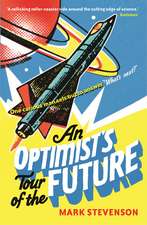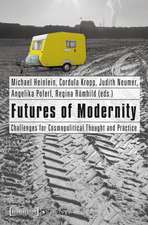Teaching about the Future
Autor P. Bishop, A. Hinesen Limba Engleză Hardback – 26 iun 2012
| Toate formatele și edițiile | Preț | Express |
|---|---|---|
| Paperback (1) | 992.32 lei 6-8 săpt. | |
| Palgrave Macmillan UK – 26 iun 2012 | 992.32 lei 6-8 săpt. | |
| Hardback (1) | 996.42 lei 6-8 săpt. | |
| Palgrave Macmillan UK – 26 iun 2012 | 996.42 lei 6-8 săpt. |
Preț: 996.42 lei
Preț vechi: 1215.14 lei
-18% Nou
Puncte Express: 1495
Preț estimativ în valută:
190.66€ • 199.07$ • 157.80£
190.66€ • 199.07$ • 157.80£
Carte tipărită la comandă
Livrare economică 04-18 aprilie
Preluare comenzi: 021 569.72.76
Specificații
ISBN-13: 9780230363496
ISBN-10: 0230363490
Pagini: 304
Ilustrații: XIX, 304 p.
Dimensiuni: 140 x 216 x 25 mm
Greutate: 0.5 kg
Ediția:2012
Editura: Palgrave Macmillan UK
Colecția Palgrave Macmillan
Locul publicării:London, United Kingdom
ISBN-10: 0230363490
Pagini: 304
Ilustrații: XIX, 304 p.
Dimensiuni: 140 x 216 x 25 mm
Greutate: 0.5 kg
Ediția:2012
Editura: Palgrave Macmillan UK
Colecția Palgrave Macmillan
Locul publicării:London, United Kingdom
Cuprins
Lists of Tables List of Figures Preface Purposes Acknowledgements Introduction Introducing the Future Why Teach the Future? The Problem of Prediction The Future(s) Be Prepared Imagine the Future Create the Future The Tricks of Foresight Telling Stories Pursuing Visions The Benefits of Foresight Structure of the Book PART I: UNDERSTANDING Models of Change Introduction Understanding Change What is Change? How Much Change is There? The Four Dimensions of Change A Model of Change: Punctuated Equilibrium 'What can we know about the future?' [Not] Predicting the Future Certainty Assumptions Types of Futures: the Cone of Plausibility Futures Methods Some Definitions Around Methods Thinking about the Future Framework Conclusion Resources Systems Thinking Introduction History Limits to Growth: Three Strikes! Generalization System Behaviours Approach Cybernetic Systems Complex Adaptive Systems Conclusion Resources Perspectives on the Future Introduction History Empirical and Cultural CriticalIntegral Generalization Approach Causal Layered Analysis Integral Futures Conclusion Resources Social Change Introduction History Generalization Explaining Social Change Critical Assumptions Approach Conclusion Resources PART II: MAPPING Research Introduction History Generalization Choosing a Domain Primary Research Secondary Research Approach Research Supports Framework Forecasting Conclusion Resources Scanning Introduction History Generalization Why Scanning is Difficult Approach Identify Scanning Hits Scan a Wide Range of Sources Operate at Different Levels of the Domain Keep an Eye on Wildcards Keep Track of Your Hits Distinguish Types of Scanning Hits Establish Criteria for Evaluating Scanning Hits Conclusion Resources Forecasting Introduction History Generalization Forecasting Theory Approach: Framework Forecasting Summary Era Analysis Baseline Forecasting Critical Thinking Baseline Analysis Creativity Alternative Futures Forecasting Scenario Kernels Conclusion Resources PART III: INFLUENCING Leadership Introduction History Era I: Traits Era 2: Situation Era 3: Effectiveness Era 4: Contingency Era 5: Shared Leadership Era 6: Managers and Leaders Generalization Leadership Distinctions Approach Leading People into New Territory Exploring Boundaries of the Possible Committing to Goals They Do Not Know How to Achieve Building Bridges When They Only Know One Side of the River Motivating People to Do What They Don't Want to Do Conclusion Resources Visioning Introduction History Generalization Attributes of a Vision Vision Statements Approach Values Background Conclusion Resources Planning Introduction History Generalization Approach Planning to Plan Understanding the Future Setting the Direction Developing the Plan Conclusion Resources Change Management Introduction History Generalization Establish a Sense of Urgency Form a Powerful Guiding Coalition . . . Is Rarely Chosen; it is Almost Always Forced by External Circumstances . . . Always Creates Disagreements About Timing and Scope . . . Is Always Uneven, Disorganized, Messy, Chaotic . . . Always Politicizes Communication . . . Always Changes the Relative Position of Groups . . . Always Occurs One Person at a Time . . . Is Never Fully Adopted by Force Approach Have a Good Reason Be Honest about the Process Articulate a Vision Commit to Achieve the Vision Communicate! Generate Trust Conclusion Resources Appendices Appendix 1: Framework Forecasting Specification Appendix 2: World Futures Appendix 2: World Futures Appendix 3: Scanning Form and Explanation Bibliography
Notă biografică
PETER C. BISHOP is an Associate Professor of Strategic Foresight and Director of the Graduate Program in Futures Studies at the University of Houston, USA. He arrived there in 2005, having taught futures studies at the University of Houston-Clear Lake campus since 1982. He received his doctorate in sociology From Michigan State University in 1974.
ANDY HINES is Lecturer and Executive-in-Residence at the University of Houston's Graduate Program in Futures Studies, USA, where he graduated in 1991 and now speaks and consults through Hinesight. He has worked as an organizational futurist with the Kellogg Company and Dow Chemical and as a consulting futurist with Coates & Jarratt and Social Technologies.
ANDY HINES is Lecturer and Executive-in-Residence at the University of Houston's Graduate Program in Futures Studies, USA, where he graduated in 1991 and now speaks and consults through Hinesight. He has worked as an organizational futurist with the Kellogg Company and Dow Chemical and as a consulting futurist with Coates & Jarratt and Social Technologies.










